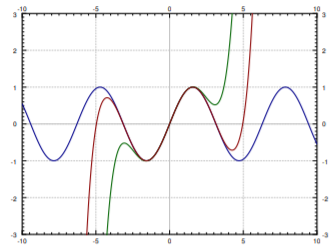7.1: Power Series
( \newcommand{\kernel}{\mathrm{null}\,}\)
Many functions can be written in terms of a power series
∞∑k=0ak(x−x0)k
If we assume that a solution of a differential equation is written as a power series, then perhaps we can use a method reminiscent of undetermined coefficients. That is, we will try to solve for the numbers ak. Before we can carry out this process, let us review some results and concepts about power series.
Definition
As we said, a power series is an expression such as
∞∑k=0ak(x−x0)k=a0+a1(x−x0)+a2(x−x0)2+a3(x−x0)3+⋯,
where a0,a1,a2,…,ak,… and x0 are constants. Let
Sn(x)=n∑k=0ak(x−x0)k=a0+a1(x−x0)+a2(x−x0)2+a3(x−x0)3+⋯+an(x−x0)n,
denote the so-called partial sum. If for some x, the limit
limn→∞Sn(x)=limn→∞n∑k=0ak(x−x0)k
exists, then we say that the series (???) converges at x. Note that for x=x0, the series always converges to a0. When (???) converges at any other point x≠x0, we say that (???) is a convergent power series. In this case we write
∞∑k=0ak(x−x0)k=limn→∞n∑k=0ak(x−x0)k.
If the series does not converge for any point x≠x0, we say that the series is divergent.
The series
∞∑k=01k!xk=1+x+x22+x36+⋯
is convergent for any x. Recall that k!=1⋅2⋅3⋯k is the factorial. By convention we define 0!=1. In fact, you may recall that this series converges to ex.
We say that (???) converges absolutely at x whenever the limit
limn→∞n∑k=0|ak||x−x0|k
exists. That is, the series ∑∞k=0|ak||x−x0|k is convergent. If (???) converges absolutely at x, then it converges at x. However, the opposite implication is not true.
The series
∞∑k=11kxk
converges absolutely for all x in the interval (−1,1).
It converges at x=−1, as
∑∞k=1(−1)kk converges (conditionally)
by the alternating series test.
But the power series does not converge absolutely at x=−1, because ∑∞k=11k does not converge. The series diverges at x=1.
Radius of Convergence
If a power series converges absolutely at some x1, then for all x such that |x−x0|≤|x1−x0| (that is, x is closer than x1 to x0) we have |ak(x−x0)k|≤|ak(x1−x0)k| for all k. As the numbers |ak(x1−x0)k| sum to some finite limit, summing smaller positive numbers |ak(x−x0)k| must also have a finite limit. Hence, the series must converge absolutely at x.
For a power series (???), there exists a number ρ (we allow ρ=∞) called the radius of convergence such that the series converges absolutely on the interval (x0−ρ,x0+ρ) and diverges for x<x0−ρ and x>x0+ρ. We write ρ=∞ if the series converges for all x.

See Figure 7.1.1. In Example 7.1.1 the radius of convergence is ρ=∞ as the series converges everywhere. In Example 7.1.2 the radius of convergence is ρ=1. We note that ρ=0 is another way of saying that the series is divergent. A useful test for convergence of a series is the ratio test. Suppose that
∞∑k=0ck
is a series such that the limit
L=limn→∞|ck+1ck|
exists. Then the series converges absolutely if L<1 and diverges if L>1.
Let us apply this test to the series (???). That is we let ck=ak(x−x0)k in the test. Compute
L=limn→∞|ck+1ck|=limn→∞|ak+1(x−x0)k+1ak(x−x0)k|=limn→∞|ak+1ak||x−x0|.
Define A by
A=limn→∞|ak+1ak|.
Then if 1>L=A|x−x0| the series (???) converges absolutely. If A=0, then the series always converges. If A>0, then the series converges absolutely if |x−x0|<1A, and diverges if |x−x0|>1A. That is, the radius of convergence is 1A.
A similar test is the root test. Suppose
L=limk→∞3√|ck|
exists. Then ∑∞k=0ck converges absolutely if L<1 and diverges if L>1. We can use the same calculation as above to find A. Let us summarize.
Let
∞∑k=0ak(x−x0)k
be a power series such that
A=limn→∞|ak+1ak|orA=limk→∞3√|ak|
exists. If A=0, then the radius of convergence of the series is ∞. Otherwise the radius of convergence is 1A.
Suppose we have the series
∞∑k=02−k(x−1)k.
First we compute,
A=limk→∞|ak+1ak|=limk→∞|2−k−12−k|=2−1=12.
Therefore the radius of convergence is 2, and the series converges absolutely on the interval (−1,3). And we could just as well have used the root test:
A=limk→∞limk→∞k√|ak|=limk→∞k√|2−k|=limk→∞2−1=12.
Consider ∞∑k=01kkxk. Compute the limit for the root test, A=limk→∞k√|ak|=limk→∞k√|1kk|=limk→∞k√|1k|k=limk→∞1k=0. So the radius of convergence is ∞: the series converges everywhere. The ratio test would also work here.
The root or the ratio test does not always apply. That is the limit of |ak+1ak| or k√|ak| might not exist. There exist more sophisticated ways of finding the radius of convergence, but those would be beyond the scope of this chapter. The two methods above cover many of the series that arise in practice. Often if the root test applies, so does the ratio test, and vice versa, though the limit might be easier to compute in one way than the other.
Analytic Functions
Functions represented by power series are called analytic functions. Not every function is analytic, although the majority of the functions you have seen in calculus are. An analytic function f(x) is equal to its Taylor series1 near a point x0. That is, for x near x0 we have
f(x)=∞∑k=0f(k)(x0)k!(x−x0)k,
where f(k)(x0) denotes the kth derivative of f(x) at the point x0.

For example, sine is an analytic function and its Taylor series around x0=0 is given by
sin(x)=∞∑n=0(−1)n(2n+1)!x2n+1.
In Figure 7.1.2 we plot sin(x) and the truncations of the series up to degree 5 and 9. You can see that the approximation is very good for x near 0, but gets worse for x further away from 0. This is what happens in general. To get a good approximation far away from x0 you need to take more and more terms of the Taylor series.
Manipulating Power Series
One of the main properties of power series that we will use is that we can differentiate them term by term. That is, suppose that ∑ak(x−x0)k is a convergent power series. Then for x in the radius of convergence we have
ddx[∞∑k=0ak(x−x0)k]=∞∑k=1kak(x−x0)k−1.
Notice that the term corresponding to k=0 disappeared as it was constant. The radius of convergence of the differentiated series is the same as that of the original.
Let us show that the exponential y=ex solves y′=y. First write
y=ex=∞∑k=01k!xk.
Now differentiate
y′=∞∑k=1k1k!xk−1=∞∑k=11(k−1)!xk−1.
We reindex the series by simply replacing k with k+1. The series does not change, what changes is simply how we write it. After reindexing the series starts at k=0 again.
∞∑k=11(k−1)!xk−1=∞∑k+1=11((k+1)−1)!x(k+1)−1=∞∑k=01k!xk.
That was precisely the power series for ex that we started with, so we showed that ddx[ex]=ex.
Convergent power series can be added and multiplied together, and multiplied by constants using the following rules. First, we can add series by adding term by term,
(∞∑k=0ak(x−x0)k)+(∞∑k=0bk(x−x0)k)=∞∑k=0(ak+bk)(x−x0)k.
We can multiply by constants,
α(∞∑k=0ak(x−x0)k)=∞∑k=0αak(x−x0)k.
We can also multiply series together,
(∞∑k=0ak(x−x0)k)(∞∑k=0bk(x−x0)k)=∞∑k=0ck(x−x0)k,
where ck=a0bk+a1bk−1+⋯+akb0. The radius of convergence of the sum or the product is at least the minimum of the radii of convergence of the two series involved.
Power Series for Rational Functions
Polynomials are simply finite power series. That is, a polynomial is a power series where the ak are zero for all k large enough. We can always expand a polynomial as a power series about any point x0 by writing the polynomial as a polynomial in (x−x0). For example, let us write 2x2−3x+4 as a power series around x0=1:
2x2−3x+4=3+(x−1)+2(x−1)2.
In other words a0=3, a1=1, a2=2, and all other ak=0. To do this, we know that ak=0 for all k≥3 as the polynomial is of degree 2.
We write a0+a1(x−1)+a2(x−1)2, we expand, and we solve for a0, a1, and a2. We could have also differentiated at x=1and used the Taylor series formula (???).
Let us look at rational functions, that is, ratios of polynomials. An important fact is that a series for a function only defines the function on an interval even if the function is defined elsewhere. For example, for −1<x<1 we have
11−x=∞∑k=0xk=1+x+x2+⋯
This series is called the geometric series. The ratio test tells us that the radius of convergence is 1. The series diverges for x≤−1 and x≥1, even though 11−x is defined for all x≠1.
We can use the geometric series together with rules for addition and multiplication of power series to expand rational functions around a point, as long as the denominator is not zero at x0. Note that as for polynomials, we could equivalently use the Taylor series expansion (???).
Expand x1+2x+x2 as a power series around the origin (x0=0) and find the radius of convergence. First, write 1+2x+x2=(1+x)2=(1−(−x))2. Now we compute
x1+2x+x2=x(11−(−x))2=x(∞∑k=0(−1)kxk)2=x(∞∑k=0ckxk)=∞∑k=0ckxk+1,
where using the formula for the product of series we obtain, c0=1, c1=−1−1=−2, c2=1+1+1=3, etc ….
Therefore
x1+2x+x2=∞∑k=1(−1)k+1kxk=x−2x2+3x3−4x4+⋯
The radius of convergence is at least 1. We use the ratio test
limk→∞|ak+1ak|=limk→∞|(−1)k+2(k+1)(−1)k+1k|=limk→∞k+1k=1.
So the radius of convergence is actually equal to 1.
When the rational function is more complicated, it is also possible to use method of partial fractions. For example, to find the Taylor series for x3+xx2−1, we write
x3+xx2−1=x+11+x−11−x=x+∞∑k=0(−1)kxk−∞∑k=0xk=−x+∞∑k=3k odd(−2)xk.
Footnotes
[1] Named after the English mathematician Sir Brook Taylor (1685–1731).


